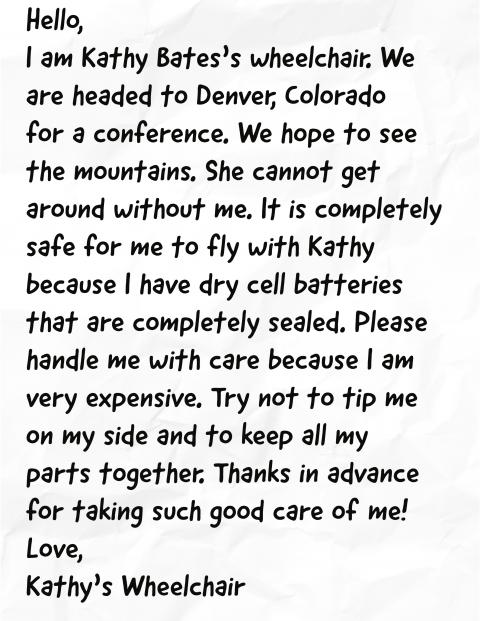Healing Broken Wings: The Airline Industry Commits to Making Travel Accessible
“No other form of transportation—trains, buses, boats—forces you to give up your mobility device when you board. And the same ought to be true of airlines.” – Pete Buttigieg, U.S. Secretary of Transportation
In a speech celebrating the 32nd anniversary of the Americans with Disabilities Act (ADA) —the law protecting the disabled from discrimination—Secretary of Transportation Pete Buttigieg spoke of several changes that are finally underway. These measures will make air travel easier for people with disabilities.
I flew for the first time with my mom on a visit to the college in North Carolina that I would attend in February of 1980. Flying was the beginning of my incredible adventures as a college student. I was beyond excited! Over the four years of my education, I got to know many of the airline attendants very well. We were all on a first-name basis. They would even ask how my classes were going! I was able to teach them the best way to handle my wheelchair and help me with my transfer on and off the plane. That made flying a little easier. However, there is nothing easy about flying for an air traveler who uses a power wheelchair.
Change is never easy but is often very necessary. Passengers with disabilities are one of the fastest-growing travel groups. Due to this increase in travel, the airline industry has begun to focus on accessibility and safety to improve air travel for those with disabilities. Seven of the nation’s passenger airlines—United, American, Southwest, Jet Blue, Alaska Airlines, Delta, and Hawaiian Airlines—have signed a pledge committing to correcting inaccessibility issues surrounding the industry.
In this pledge, each airline will create a passenger accessibility committee to work with the disability community and support the development of new accessibility measures. The group will work to develop policies that ensure accessibility is a priority. Training in the handling of wheelchairs and other mobility equipment will also be required for all employees.
In July 2022, the U.S. Department of Transportation issued the first Bill of Rights for airline passengers who are disabled, empowering these passengers to seek out the help they require while traveling. The 10 basic rights are user-friendly and a part of the Air Carrier Access Act (ACAA), which protects passengers with disabilities from discrimination. The Airline Passengers with Disabilities Bill of Rights was developed with input from passengers with disabilities and national disability organizations, as well as aircraft designers and wheelchair manufacturers.
The Bill of Rights consists of:
1. The Right to Be Treated with Dignity and Respect.
2. The Right to Receive Information About Services and Aircraft Capabilities and Limitations.
3. The Right to Receive Information in an Accessible Format.
4. The Right to Accessible Airport Facilities.
5. The Right to Assistance at Airports.
6. The Right to Assistance on the Aircraft.
7. The Right to Travel with an Assistive Device or Service Animal.
8. The Right to Receive Seating Accommodations.
9. The Right to Accessible Aircraft Features.
10. The Right to Resolution of a Disability-Related Issue.
This Bill of Rights is just the beginning of the changes that we will eventually see. A National Academy of Sciences (NAS) report, requested by Congress, found that it would be technically possible to secure personal wheelchairs on commercial airlines if two rows of seats are removed. In the coming years, we can also expect a very important feature on airplanes—accessible bathrooms. Hallelujah!
The NAS report stated that many wheelchairs already meet some crash standards used by the Federal Aviation Administration (FAA) for existing aircraft seats, though there is a need for more testing. In addition, the report noted that the best place to create the wheelchair space would be in the two front rows of the airplane where first-class seats are located. Of course, these changes won’t happen overnight, and there will likely be pushback from airlines regarding the loss of two rows of their most expensive seating in exchange for accessible space for personal wheelchairs, including power chairs. That’s okay. It will take me a few years to save up for my dream trip to Paris!
From Where I Sit

In 2019, the first full year of reporting, 10,548 wheelchairs or scooters were lost, damaged, delayed, or stolen. That amounts to roughly 29 per day. The price of my brand-new power chair was $27,547 in 2014. This is the same price as a luxury car, but baggage handlers do not get training on how to operate wheelchairs like mine. It is put on a conveyer belt like a regular suitcase. The difference is that I can’t get around without my chair. My chair has been damaged several times, including the time when my chair came back to me in six pieces. I know that my chair is very difficult to load onto a plane because it weighs around 500 pounds. I do not doubt that it would be a lot easier to access air travel if I could drive it onto the plane and safely secure it for the flight. I have done this more times than I can count on buses and in my van. Not to mention how difficult it is to board a plane if you can’t walk. You get transferred onto a piece of equipment that looks like a dolly with a seat on it and then you are transferred into your seat. It is extremely awkward, to say the least. In my case, my feet never touch the floor, and my head never reaches the headrest. It is incredibly uncomfortable, especially on long flights. No one is more excited than I am about all of these new changes. For so long, the hassle of flying has kept the dream of travel just out of reach for many people with disabilities, and now, the sky is the limit!
